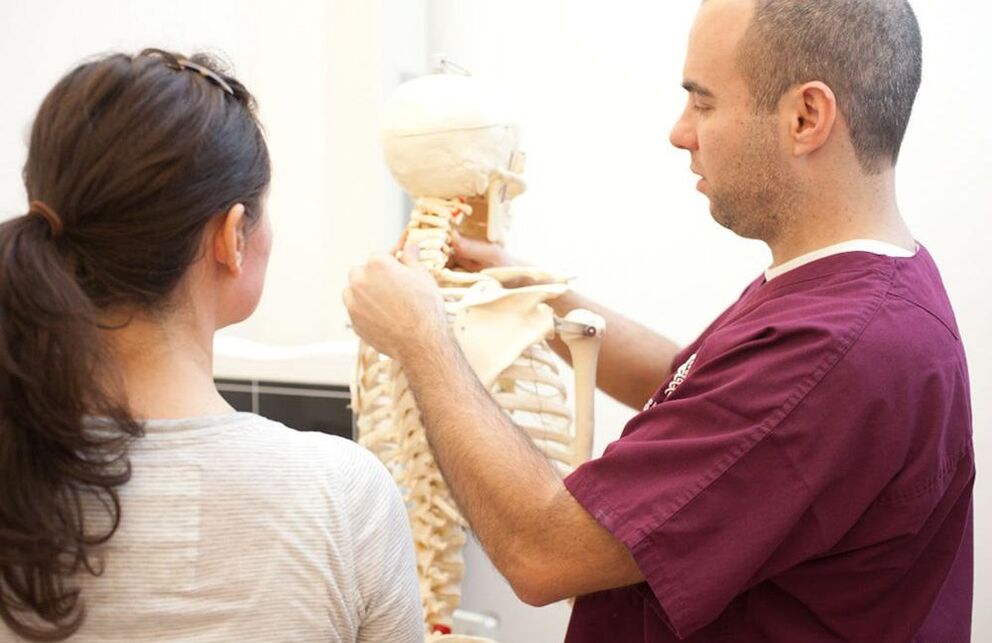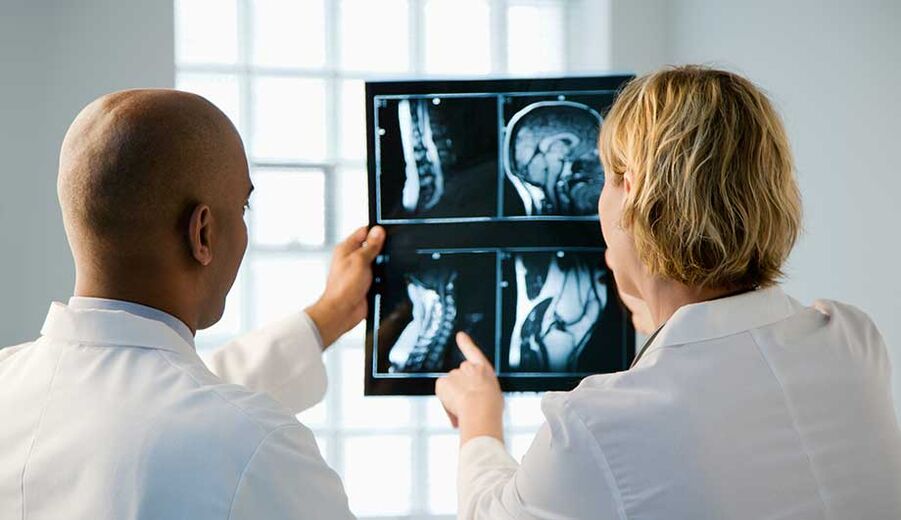
In this article, we examine the symptoms and treatment of cervical spine osteochondrosis. What is this pathology? How does it manifest itself?
Osteochondrosis is a disease that is practically the most common in the world. Many suffer from this pathology in various forms after 30 years. There is also a tendency to rejuvenate the disease, that is, to lower the age limit. This may be due to the fact that nowadays more and more people are engaged mainly in work where one spends most of the time sitting and living a sedentary lifestyle. By the way, such a disease is dangerous and all people need to know what cervical osteochondrosis is, how it appears, how to treat it and how to identify its symptoms.

The main causes of the disease
Man has been designed so that the vertical placement of the spine can result in the vertebrae becoming increasingly compressed over time, thereby allowing bone and cartilage tissue to gradually degrade and deform.
The spine always begins with the cervical region, which has seven vertebrae. This is a particularly vulnerable part, as mobility in this area has increased. Such disease of the cervical spine is mainly reflected in the plates because it is a weak point of the spine.
The incidence of degenerative disc diseases in the cervicothoracic region is aided by factors such as the small size of the vertebrae and the relative weakness of the neck muscles. In addition, poor blood supply to cartilage tissue affects the developing disease. What does all this mean?
Judging from this, the development of the disease seems to be a long and complex process where it is very difficult to recognize the cause. Although an association has been found between a sedentary lifestyle and osteochondrosis of the cervicothoracic spine, they nevertheless often experience a similar disease in trained people, especially athletes, as they have an increased load on the cervical spine. Different weights (dumbbells, weights) are lifted, which leads to deformation of the discs. So everything needs to be measured.

In older people and the elderly in general, such degradation of the structure of the vertebrae is an inevitable process, which in turn is accompanied by aging of the body and weakness in its defense. But there may also be an abnormal type of osteochondrosis of the cervical spine, the symptoms of which are due to internal or external negative factors. These include:
- various back injuries;
- rachiocampsis;
- heavy weight;
- improper posture;
- hypodynamics;
- hard physical work;
- disturbed metabolic processes;
- hypothermia;
- overtime, stress;
- infectious diseases;
- heredity;
- congenital pathologies or peculiarities of body structure.
Stages of osteochondrosis of the cervical spine
The pathology consists of four stages. According to the general analysis, it is sometimes quite difficult to determine at what stage of the disease the patient is, as the degree of bone degradation is most often not the same as the symptoms observed in the patient.
The first stage of the disease
At this stage, destructive actions are already taking place in the vertebrae. But the symptoms of cervical osteochondrosis are not yet pronounced. People may not notice them or may not associate these signs with spinal disease, called stress or banal overload.
The second stage of the disease
As already mentioned, the symptoms and treatment of cervical osteochondrosis are closely related.
At this stage, there is a noticeable thinning of the plate and cracks appear on its surface. Symptoms of cervical osteochondrosis are observed at this stage with constant pain, facial numbness, weakness.

Third stage
How do symptoms of cervical spine osteochondrosis manifest themselves at this stage? Herniated discs occur, cervical vessels and muscles are affected. The person experiences dizziness and pain in the back of the head.
The fourth stage of the disease
With osteochondrosis of the cervical spine, osteophytes often occur - a proliferation of bone tissue that protects the vertebrae from stress, resulting in nerve stings. This is characterized by stiffness of movement and damage to adjacent joints.
Signs of cervical osteochondrosis
The main symptoms of osteochondrosis of the cervical spine are:
- Sharp pain in the shoulders and neck.
- Muscle weakening.
- Increased sweating.
- Impaired coordination.
- Numbness in the hands.
- Dizziness.
- Hypertension.
- Decreased hearing and vision.
- Headache.
Common symptoms of osteochondrosis of the cervical spine can manifest at any stage of the disease. In most cases, only a few characters are visible from the list, while others may be missing. The patient who first met them has virtually no diagnosis of cervical osteochondrosis. In this case, you can consult different doctors - cardiologists, neuropathologists, therapists, surgeons. And in the end, a reliable diagnosis can be identified with a significant delay.
Danger of pathology
Not everyone is familiar with the symptoms and treatment of cervical osteochondrosis.
The initial symptoms of osteochondrosis can appear as early as age 20, while the pain and discomfort are mild, so many choose to wait, hoping that the symptoms will go away, postpone a visit to the doctor, and not start treatment. In the early stages of osteochondrosis, the symptoms may indeed disappear on their own, but this disease will not go away from a person. If prevention and therapy are not carried out, osteochondrosis will continue to develop and this could be dangerous to human health.

What are the dangers of osteochondrosis of the cervical spine?
In the first stage, the symptoms are mild, so most people prefer not to take this disease seriously. But if the patient does not start treatment early in development, it can lead to dangerous, serious complications. The consequences of a neglected phase are conditions in which a person is unable to perform his or her duties. This can often be accompanied by lesions in neighboring classes. Such abandoned osteochondrosis leads to very dangerous consequences and then disability.
In addition, the following may develop:
- bulging of the intervertebral discs;
- protrusions and intervertebral hernia;
- loss of discs;
- lumbago or sciatica;
- spinosis of the spinal canal.
In special cases, the diseases listed above are forced to undergo surgery, and the advanced stage results in disability.
The problems listed above are characteristic of osteochondrosis of the cervicothoracic spine.
Complications of the disease
The risk of the disease is that the neck region attaches to the vessels that supply blood to the brain. The consequences of osteochondrosis of the neck are sleep disorders, migraines, visual disturbances, dizziness. In case of advanced disease, the listed symptoms will be more noticeable. There is a possibility of concomitant problems in cervical osteochondrosis:

- high or low blood pressure and vascular dystonia;
- thyroid disease;
- vestibular disorders;
- high blood pressure or hypotension;
- stroke;
- epicondylitis;
- humeroscapularis periarthrosis.
Diagnosis of cervical spine pathology
The symptoms and treatment of osteochondrosis of the cervical spine are of interest to many.
You should consult a therapist for a correct diagnosis. Provides referrals to other professionals - neurologist, vertebrologist, orthopedist.
The following types of tests are included to diagnose the disease:
- CT scan;
- radiography;
- MRI;
- Doppler scanning.
X-ray examination reveals the presence of growths, vertebral displacement, salt deposits and osteophytes, disc seals. With the help of computed tomography, you can get a fairly voluminous image of the organs, in this case the cervical spine. It allows you to detail the stage of the pathological process as well as the nature of the nerve constriction, the height of the plates, and the structure of the osteophytes. Magnetic resonance imaging provides an even more detailed picture of the structure of the spine. Ultrasound helps determine how blood flow has changed in the large blood vessels in the neck caused by the disease.

Treatment of this disease
The symptoms and treatment of osteochondrosis of the cervical spine are interrelated.
In order for a person to be able to resist disease, medicine is developing a number of methods. There are also therapies that you can use at home. But this procedure is lengthy and complete recovery is unlikely, especially in old age. But it is also worth noting that at any stage of the disease, pathological processes in the spine can be stopped and slowed down.
In the first stage of the disease, methods of treating osteochondrosis of the cervical spine are mostly conservative. There are several methods that can be used in therapy:
- physiotherapy;
- medicines;
- massage;
- physiotherapy;
- special devices for fixing the spine.
If such a disease has entered an extreme stage while the osteochondral structure of the spine has been destroyed, surgery should be used to cure osteochondrosis of the neck.
Drugs for the treatment of pathology
Necessary drugs for the treatment of osteochondrosis of the cervical spine:
- analgesics;
- vitamins;
- chondroprotectors;
- anti-inflammatory drugs;
- antispasmodics.
When acute pain syndrome occurs, which is associated with osteochondrosis, the most important task is to remove it. In such cases, oral painkillers are taken, but if their effects are not noticeable, novocaine blockade may be used.
The symptoms and treatment of cervical spine osteochondrosis are often disputed by many.
They often take antispasmodics. Muscle relaxants show the greatest efficacy in osteochondrosis. The patient may use ointments containing non-steroidal drugs as analgesics and anti-inflammatory agents.
If there are signs associated with impaired blood supply to the brain and vertebral artery syndrome, medications should be used that remove their unpleasant manifestations — antihypertensive and nootropic medications.
The symptoms and treatment of osteochondrosis of the cervical spine are no longer a secret.

Physiotherapy exercises
Physiotherapy is the simplest and most accessible type of therapy and type of prevention of cervical osteochondrosis, moreover, it is quite effective. Physiotherapy can also be done at home. In cervical osteochondrosis, the saturation of the classes does not play a big role, only their regularity is needed. Above all, physical education aims to strengthen the neck muscles, which is responsible for compensating for the lack of spinal functionality and helping to support weakened vertebrae. Treatment of osteochondrosis of the cervical spine should be regular.
Daily exercise is needed to strengthen the muscles. Such exercises can be very simple, including turning and tilting the head in different directions, and quite complicated in which the hands help the neck muscles. They can be done at home and at work. For example, if you have to work constantly while sitting, it is very helpful to do different exercises every hour when you are sitting at a table and on a monitor. But this should only be done if there is no worsening of the disease and no pain syndrome. Otherwise, the same practices can only aggravate the condition.
It is also effective in treating osteochondrosis of the cervical spine to strengthen the muscles of the shoulder girdle, such as using light dumbbells in regular exercises. However, lifting weights like a kettlebell or barbell is contraindicated. Regular swimming can be helpful as it relieves spinal strain.
We examined the symptoms and treatment of cervical spine osteochondrosis.















































